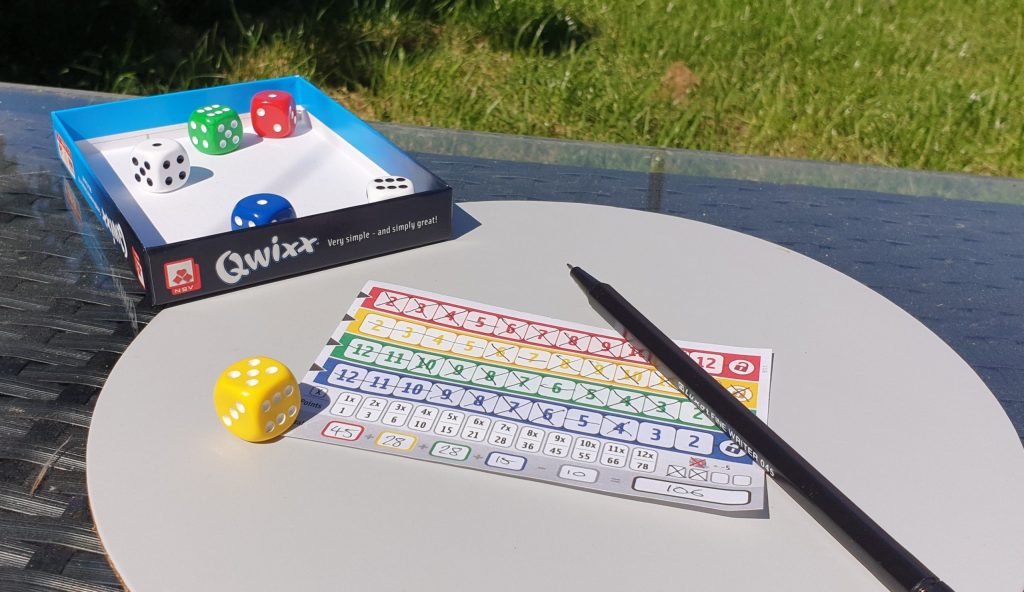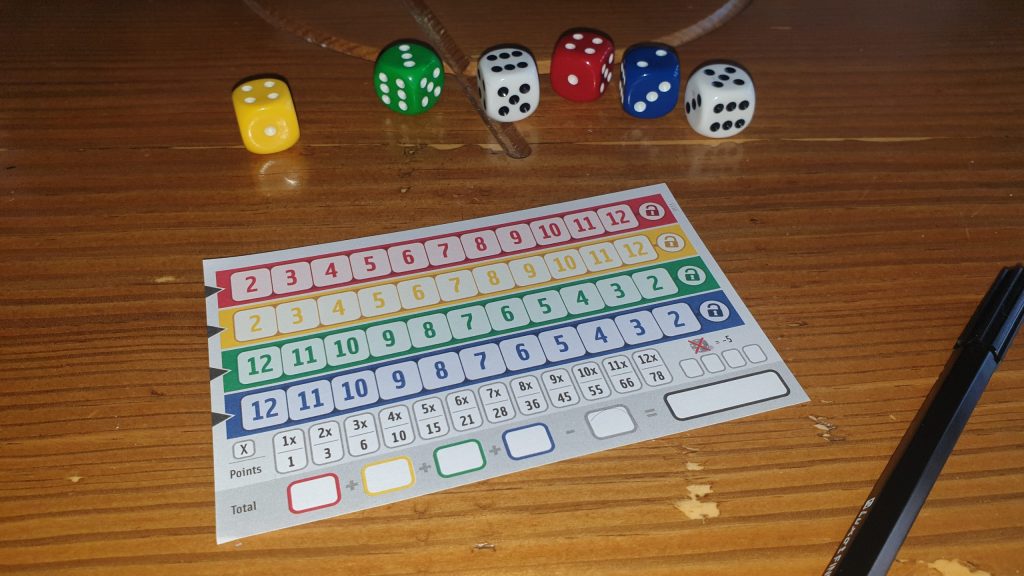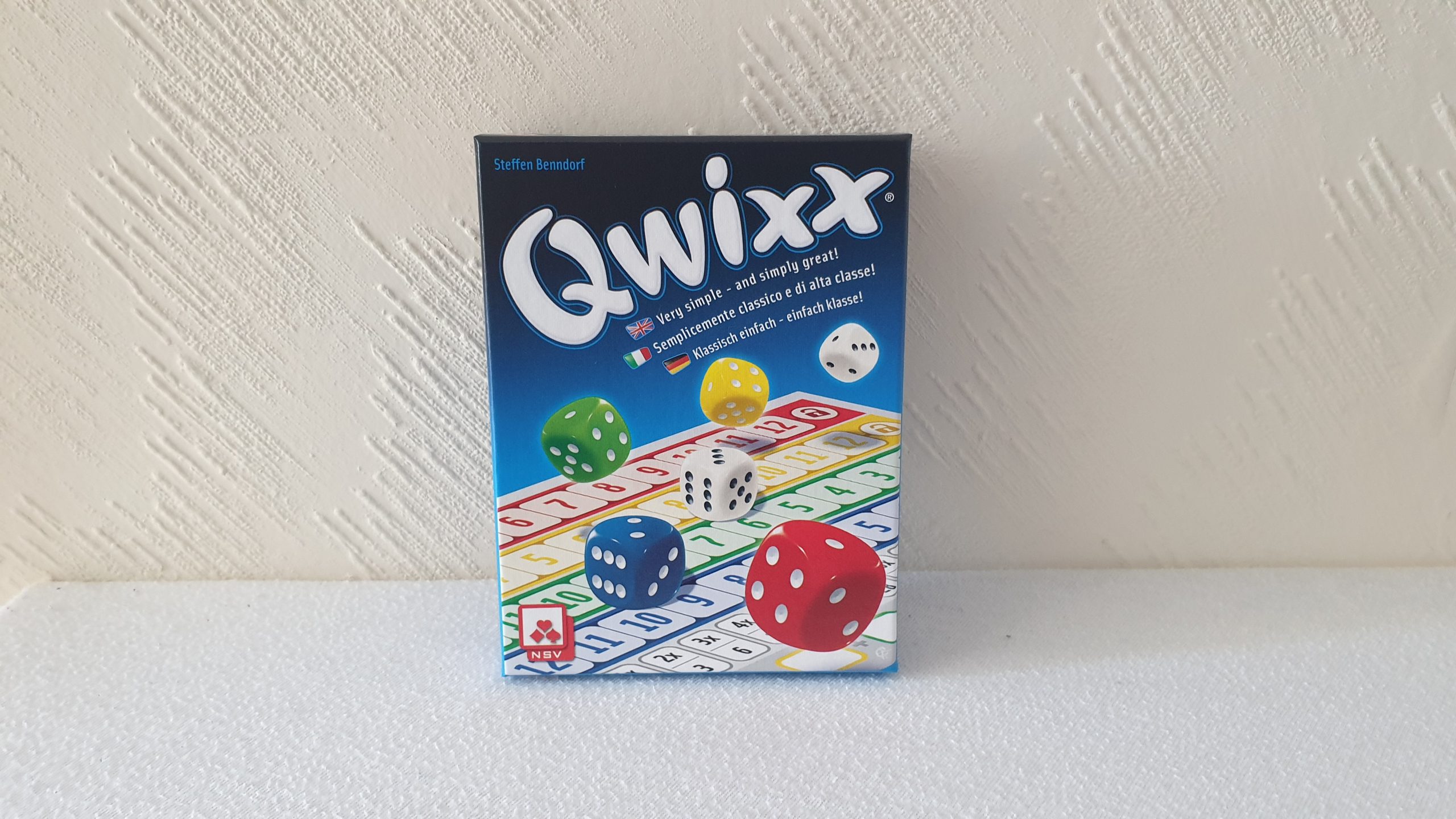Qwixx is a roll and write game from German publisher Nürnberger-Spielkarten-Verlag, which was originally released back in 2012. Designed by Steffen Benndorf, the game sees 2 – 5 players rolling dice and filling in their scoresheets. Taking around 15 minutes the concepts are simple to teach. However, will this still grab gamers’ attention today? Let’s find out!
Passing everyone a scoresheet, the dice to one player and each grabbing a pen is as far as setup goes with Qwixx. The design of the scoresheets is such that there are 4 coloured rows. There are labeled boxes going from 2 to 12 in red and yellow and from 12 to 2 in green and blue. As a rule players will be crossing off these boxes from left to right, being unable to cross off any in the future that they pass over.
Played over a series of rounds, each sees the active player roll the dice. All players are then able to use the combined value of the two white dice to cross off a value on their scoresheet. Initially, this can be on any of the four coloured rows. The active player that rolled the dice is then able to combine either of the white die values with one of the four coloured dice, crossing off that number on the appropriate colour row. The active player must choose to do one of these options, else they take an X mark – worth -5 points at the end of the game. All other players are free to use the combined value of the white dice or not, with no repercussions.
To help with remembering that players can only fill in the rows from left to right, when skipping over numbers it is suggested to put a line through them. Skipped numbers are not directly negative points. However, the aim is to cross off as many numbers in a row as possible, as this will garner the most victory points. Once a player has 5 numbers crossed off on a row, and the dice roll allows for it, they can choose to cross off the rightmost number in a row. For example, if a player has 5 crossed off numbers on the red row, and the white dice totalled 12, they could cross off the final box of the red row. The player gets to cross off the padlock for the row boosting their score. When this occurs, the coloured die associated with the row is removed from play and no one can cross off numbers from the row for the rest of the game.

Once everyone has chosen whether or not to use the value to cross something off, the game continues with the next player becoming the active player. The game ends when one of two conditions is met. If either two or more colours are locked at the end of a turn or one player has taken their 4th X mark, the game is over. At this point players determine their score for each row. Using the table on the scoresheet they convert the amount of crossed off numbers (including the padlock) into a points value. Summing these points together, and subtracting any negative points from X marks, the player with the most points wins.
The simple aim of Qwixx, to cross off as many number spaces as possible, is extremely easy to convey. This helps the game very quickly hit the table and for play to begin. Alas, the rule of 5 crosses in a row, before the last number can be crossed off, is easy to forget when playing. Despite the padlock symbol on the scoresheet, there could have been something highlighting the final space – be it a special border or making it fully linked to the padlock with a small 5X symbol. Even a slight separation from the other boxes would have made this clearer. It looks like players should be able to fill it in as normal, and it certainly trips some up.
6 dice are rolled on opponents’ turns but you are only interested in two of them. In a 2 player game this is slightly lackluster, in a five player game you’ll have seen up to a total of 24 dice rolled before it is your first turn, and between turns, whilst only being able to use 8. This ratio is a bit too low for my liking, it allows players to get lucky or unlucky with rolls and benefit from that and not their choices.
A careful balance of risk and reward is at the core of Qwixx. There is constantly the risk of not taking a number, which will see a row left empty when an opponent locks it. Another angle of risk is by taking a number that skips others. Compounding this is the risk of taking a number on an opponent’s turn. Players have to weigh up the additional points with the limitation they are giving themselves for on their own turns, when they must cross off a number or suffer a negative X mark. Having predominantly lost most games of Qwixx I can say getting this balance right isn’t an easy one. Still, walking the line between the two perfectly can result in a huge amount of points.

Much like with Qwinto, a recent sequel of sorts, the components of Qwixx are designed to be more functional than impressive. The scoresheets are thin paper, and could have been double sided. They also look closer to an Excel spreadsheet than a board game that people would be drawn to. The dice are fairly standard, which isn’t exactly a selling point. One part players will have to provide however are pens/pencils which are not included. Very few roll and writes fail to provide at least some pens. While it’s not like gamers wont have pens or pencils lying around the house, it means the game isn’t one you can just grab and throw in a bag without thinking ahead.
It is hard not to compare Qwixx to Qwinto, though despite their limited and similar components they do play differently. With a few rules such as not being able to fill in spaces once you have decided to skip them, very different choices need to be made. Players have much more to do as the active player, compared to the other players around the table. Qwinto offered a simple re-roll as the active players additional benefit. This felt closer to all players being in the same boat when choosing how to use a number. Those that prefer the ability to have occasionally a slightly bigger turn, via writing more than one number, will probably prefer Qwixx due to this. Otherwise, Qwinto’s method of everyone having the same choices, with only the decisions making the difference, makes the result feel more meaningful.
(Editor’s Note: Qwixx was provided to us by Coiledspring Games. Check out the official webpage here.)

